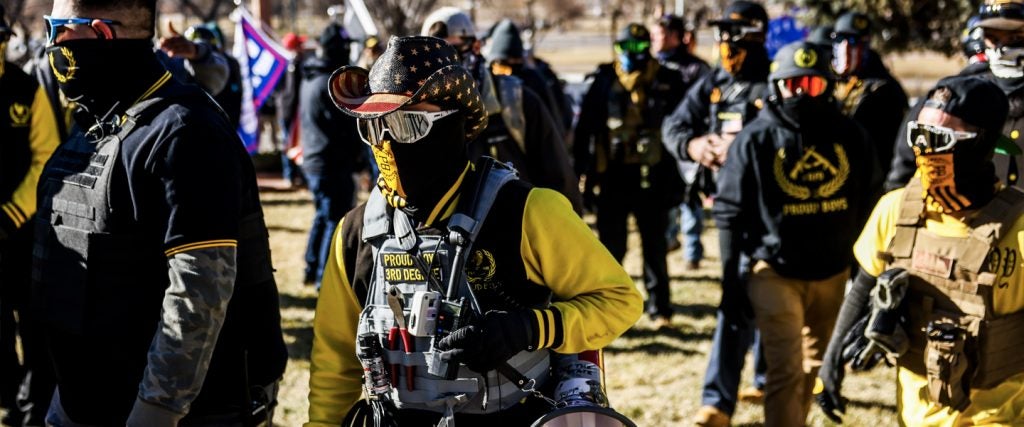Yesterday, Cassidy Hutchinson, former aide to Donald Trump’s chief of staff Mark Meadows, dropped a major revelation in her testimony to the January 6th House Select Committee hearing: She alleged that she heard several conversations about Proud Boys and Oath Keepers in the White House, specifically around Trump’s lawyer Rudy Giuliani.
Though many political observers suspected that the White House was aware of how violent and chaotic the day would become, Hutchinson’s testimony was the first time an insider drew a firm line between leadership in D.C. and the far-right extremist groups who smashed and shoved their way into the U.S. Capitol building.
As the nation wrestles with the residue of the insurrection, what is becoming clear is how calls for violence against political enemies are increasingly coming from inside the house. This may be literally true in the case of the White House, but this week’s testimony is also crucial context as more far-right politicians cozy up with their most aggressive extremist fans, all in the name of the conservative culture war.
The build-up began before the election, including in a September debate when Trump chose not to condemn the Proud Boys and their far-right ilk, instead asking them to “stand back and stand by.” Later, in December, Trump fully fanned the flames by tweeting for his supporters to show up in Washington, D.C. for a “wild” rally on January 6th — a “pivotal movement” in the run-up to the Capitol attack, as House Rep. Liz Cheney, vice chairwoman of the January 6th committee, observed earlier this month.
On the eve of the insurrection, Trump instructed Meadows to reach out to far-right political operative Roger Stone and former national security adviser Michael Flynn, Hutchinson said. And ultimately, on the day of the insurrection, Trump allegedly became enraged while witnessing efforts to stop “his supporters” from attending his speech on the Capitol grounds.
“I don’t fucking care that they have weapons, they’re not here to hurt me. They’re not here to hurt me. Take the fucking mags away,” Trump allegedly said, referring to the security magnetometers used to screen attendees. “Let my people in. They can march to the Capitol from here, let the people in and take the mags away.”
Despite claims from Proud Boy leaders like Enrique Tarrio that the group had “no plans for violence” and wanted to stay away from other protesters during the Capitol riot, in reality, the Proud Boys were right in the thick of it, using their strategic planning and command hierarchy to communicate and move in lockstep with the masses. Indeed, Proud Boy members took aggressive roles in multiple breach points at the Capitol, often taking the lead in dismantling police barricades. Members also repeatedly instigated others around them, urging them to revolt and storm the Capitol building, per video evidence.
Given the full picture, it’s hard to shake the notion that Giuliani, Meadows, Trump and others did more than just fail to anticipate violence. The evidence suggests they stared at the intel, realized the potential for a historic uprising and did everything they could to allow for chaos to unfold. In fact, Trump allegedly watched the riot on television and angrily stated that Vice President Mike Pence deserved the chants from people calling for his hanging.
In the immediate aftermath, it seemed like the Proud Boys were in disarray, with reports that snitching, internal power struggles and distrust of national leadership (namely Tarrio) had fractured the group’s strength. More than 18 known Proud Boys have been arrested and identified for their participation in the insurrection, and they’ve failed to make many national splashes since.
But January 6th marked a different kind of turning point for these extremists, as they turned away from organizing around national issues to focusing on the local level, where disruptions of school boards, local political meetings and LGBTQ events have made Proud Boys more relevant than ever in their communities. The support of Trump helped astroturf the Proud Boy fringe into the mainstream political consciousness, and they’ve become key allies and muscle for some far-right elected officials. Some Proud Boys are even seizing the moment to run for office, seemingly unencumbered by their extremist histories.
There are more than a half-dozen current and former Proud Boys who have secured positions on the Miami-Dade Republican Executive Committee — a perfect position to influence local agendas and elevate fringe candidates. These figures include people who face criminal charges for participating in the Capitol attack, such as Gilbert Fonticoba and Gabriel Garcia, a former Army captain who was charged with interfering with law enforcement officers during the insurrection. A Proud Boy ran for a Oregon legislature seat earlier this year, and another former Proud Boy lost a race for a Topeka City Council seat in Kansas, despite making it through the primaries.
And even when they’re not running for office, they remain close to Republican politicians and candidates — a trend that we’ve certainly seen with the Oath Keepers, who have dozens of ties to established elected officials, as well examples of far-right politicians like Idaho State Rep. Heather Scott, who used a Christian biker club to promote anti-LGTBQ sentiments earlier this year.
The lines between America’s mainstream political machine, and the far-right agitators looking to make moves within it, continue to blur. It’s no longer merely about who in the White House knew what on the eve of January 6th, as the blueprint for disruption is now being adapted to smaller levels of government.
Trump was the first president, and maybe the first American politician, to truly lean into the value of extremist populism in the 21st century. The revelations from the ongoing hearings — and the ongoing weaving of the Proud Boys into our political fabric — only continue to prove why he won’t be the last.

